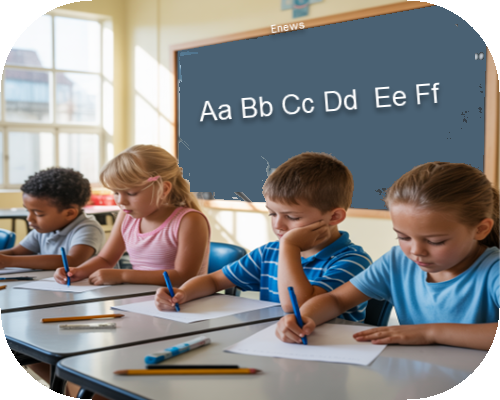Our K-12 education system is in an undeclared state of emergency. That’s the stark assessment from the National Assessment of Education Progress (NAEP, or the Nation’s Report Card).
Like other recent results, the level of education catastrophe should surprise no one. Like before, we’re already seeing a surge of public hand-wringing and headlines of concern that will fade with the next news cycle. Unlike before, there is a chance to do something different in every state. We have to take it.
Tucked in the One Big Beautiful Bill was the nation’s first federal school choice tax credit, the most significant federal education policy in generations. Advocates have been working toward it for decades, and it first became a real possibility under then-Education Secretary Betsy DeVos. Now, one final barrier remains — governors must opt in so that their states can participate in the tax credit.
With these latest results, it’s clear what they must do.
The results are nothing short of a five-alarm fire, with 12th-grade math and reading scores clocking in lower than in 2005 and 1992, respectively. We’re looking at a lifetime’s worth of learning down the drain, as the bottom continues falling out and achievement gaps become insurmountable gulfs.
The kids are not all right.
The outcomes shock the conscience, but they are not a surprise. Students taking this test entered high school in 2020. That’s when education leaders were carrying coffins at protests, successfully agitating for more extended school shutdowns, extorting billions and billions in new spending from taxpayers, and assuring the nation that “kids are resilient.” The kids — especially those most vulnerable and in need of a quality education — were already falling behind.
Now, seniors who are about to walk across a stage, grab a diploma, and step into adulthood are less prepared to read, write and do math than their parents or even their grandparents were at the same age.
The scores speak for themselves.
—In science, just 31 percent of eighth-graders performed at or above “NAEP Proficient.”
—In math, just 22 percent of 12th-graders were at or above proficient.
—In reading, 35 percent of 12th-graders were at or above proficient.
This means that 69 percent of eighth-graders would struggle to describe the function of the circulatory or respiratory system or identify basic science practices. Just 22 percent of high school seniors could successfully carry out equations like finding the perimeter and the area of a figure. Just 35 percent of high school seniors can reliably read and understand a book and draw inferences about the author’s tone and word choice.
Things are bleak for the students still in school. These scores show that almost one-third (31 percent) of 12th-graders reported missing three or more days from school in the previous month in 2024. That’s a 5 percent jump from 2019 and similar to patterns for fourth- and eighth-graders that were seen in prior results.
Let’s be blunt. The system has neither incentive nor ability to fix itself, and America’s kids can’t wait any longer for them to figure it out. We know they’ll ask for more money, and we know it won’t work.
Taxpayers send nearly $900 billion to K-12 public education every year. It’s long past time to break away from the calls for more and instead ask where the money is going — and try something different: Real options.
Thanks to the recently passed federal school choice tax credit, actual options can come. If governors opt in, every state can incentivize donor-funded scholarships through federal tax credits for donors up to $1,700. At the same time, scholarship-granting organizations can offer a variety of scholarship amounts and purposes that meet the unique needs of students. Similar to programs that already exist in 18 states, this credit would offer a desperately needed mechanism for families who can’t afford options on their own.
It’s no secret that school choice is popular, and it’s no surprise that it reached terminal velocity during and immediately after the COVID-19 failures. It’s not just a political winner; it’s a moral imperative. Every governor must opt in to unlock genuine accountability and competition in the nation’s school system. Kids can’t afford to wait.
How useful was this article ?
Click on a star to rate it!
Average rating 0 / 5. Vote count: 0
No votes so far! Be the first to rate this post.
We are sorry that this post was not too useful for you!
Let us improve this post!
Tell us how we can improve this post?










Related Articles
Protecting a Tool That Builds an Efficient, Thriving Economy – Inside Sources
Opinion: When Children Walked to School -Terence P. Jeffrey
Speech and Political Violence in the Spotlight – Inside Sources
Opinion – America Divided: Charlie Kirk’s Assassination – Kevin DeAnna
The Return of the Trump Turncoats | Inside Sources
Free Speech is Too Expensive. Charlie Kirk Paid With His Life – Inside Sources
To Save Medicare, Stop Fraudulent Billing – Inside Sources
The Last Witnesses – Inside Sources
Recent Articles
Opinion: Surveys on Political Violence Are Criminally Misleading – David Harsanyi
The oldest pipe organ in the Christian world sounds after 800 years of silence – Associated Press
Secret Service dismantles telecom threat around UN capable of crippling cell service in NYC – Associated Press
Scientists discover a new dinosaur from Argentina with a crocodile bone in its mouth – Associated Press
Mayor Phil Goode’s Weekly Update, September 22, 2025
Arizona Weekly Gas Price Update for the Week of September 22, 2025
Back to Home Page